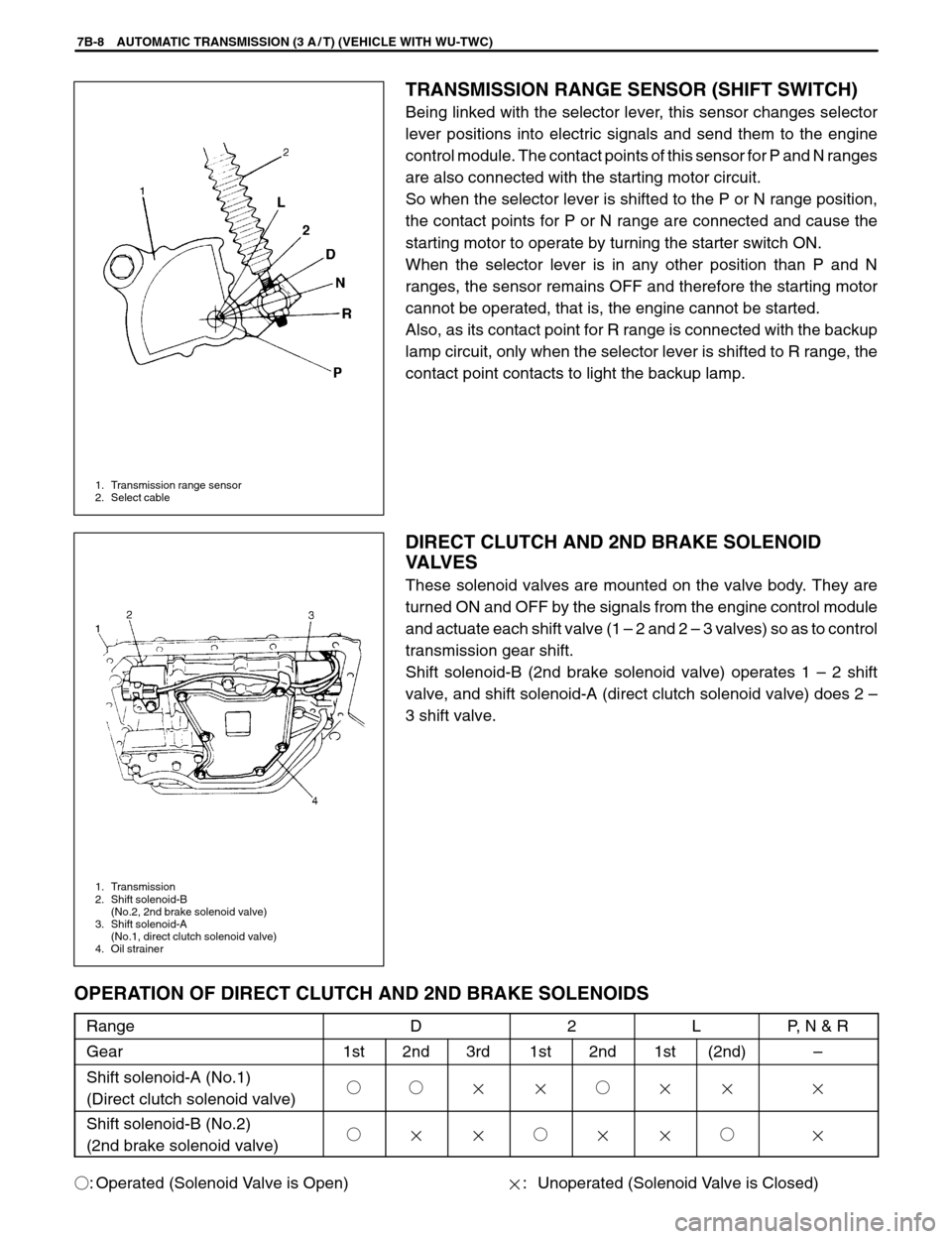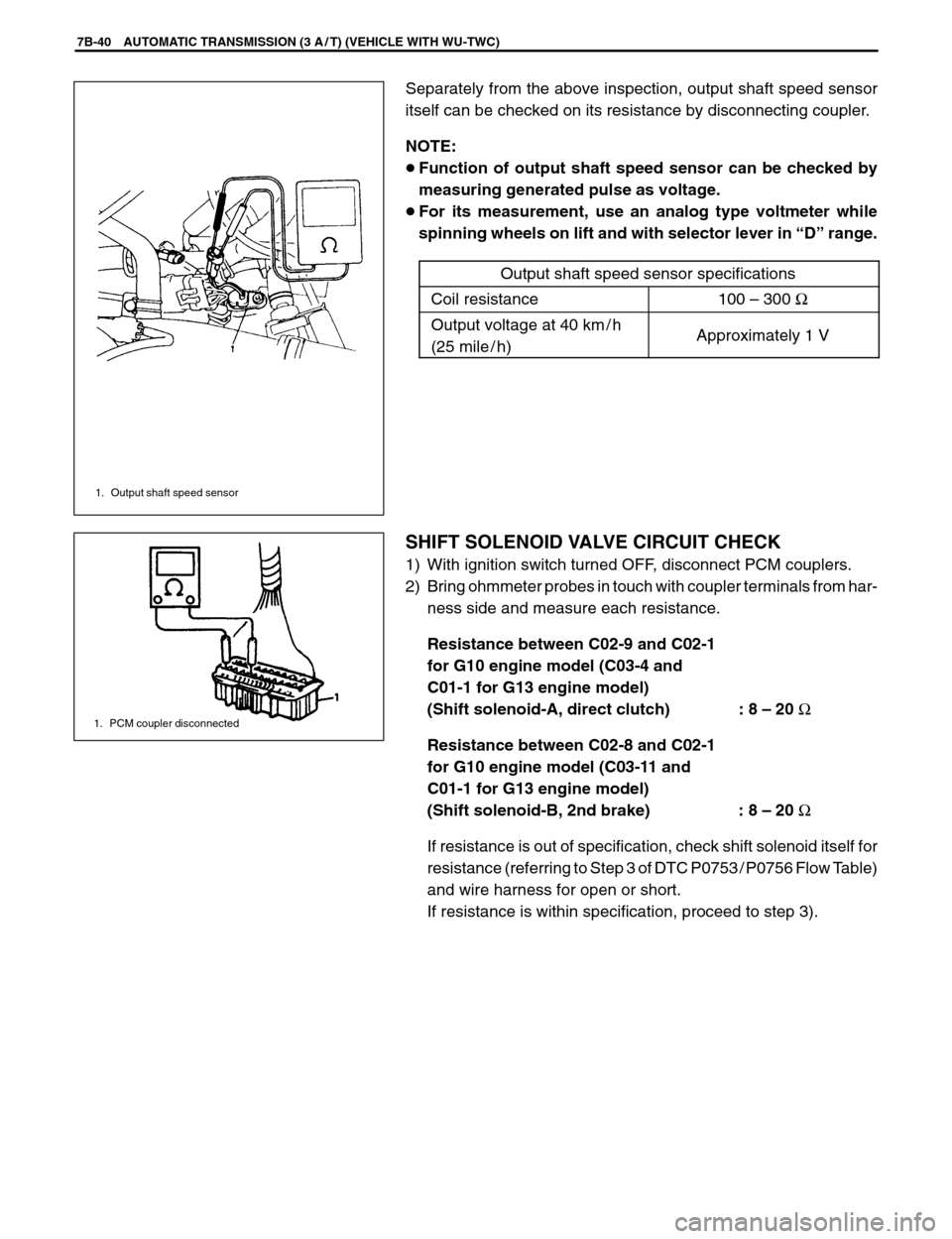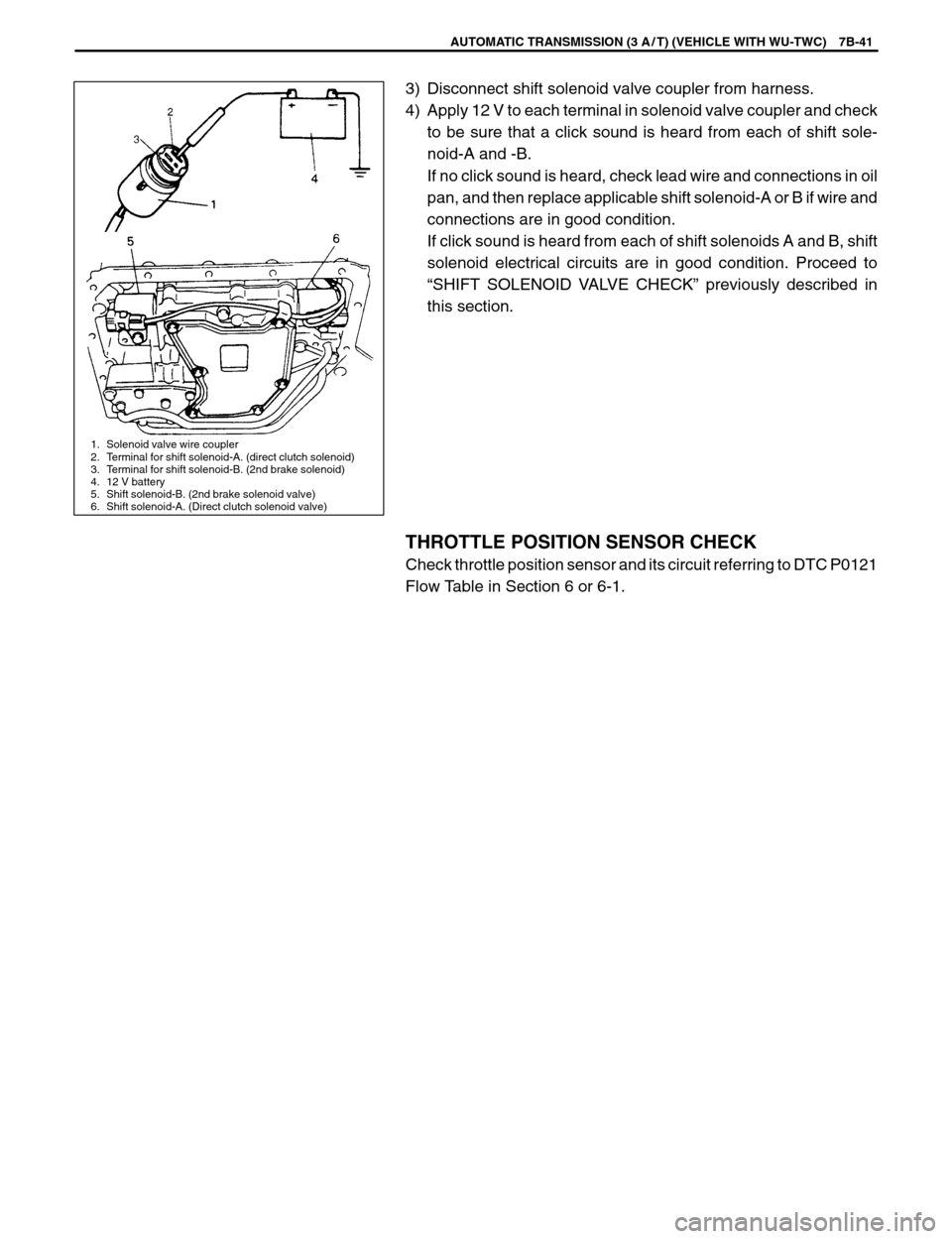Page 496 of 557
[G10 Engine Model]
1. PCM
2. Camshaft position (CMP) sensor
3. Throttle position (TP) sensor
4. Engine coolant temperature (ECT) sensor
5. Transmission range sensor (shift switch)
6. Output shaft speed sensor (A / T VSS)7. Malfunction indicator lamp (MIL)
8. Data link connector (DLC)
9. Shift solenoid-A
(No.1, Direct clutch solenoid valve)
10. Shift solenoid-B
(No.2, 2nd brake solenoid valve)11. Ignition switch
12. Main relay
13. Inhibitor switch
14. To starter
15. Terminal arrangement of PCM coupler
(Viewed from harness side)
AUTOMATIC TRANSMISSION (3 A / T) (VEHICLE WITH WU-TWC) 7B-5
ELECTRONIC SHIFT CONTROL SYSTEM
Page 497 of 557
7B-6 AUTOMATIC TRANSMISSION (3 A / T) (VEHICLE WITH WU-TWC)
[G13 Engine Model]
1. PCM
2. Camshaft position (CMP) sensor
3. Throttle position (TP) sensor
4. Engine coolant temperature (ECT) sensor
5. Transmission range sensor (shift switch)
6. Output shaft speed sensor (A / T VSS)7. Malfunction indicator lamp (MIL)
8. Data link connector (DLC)
9. Shift solenoid-A
(No.1, Direct clutch solenoid valve)
10. Shift solenoid-B
(No.2, 2nd brake solenoid valve)11. Ignition switch
12. Main relay
13. Inhibitor switch
14. To starter
15. Terminal arrangement of PCM coupler
(Viewed from harness side)
Page 498 of 557

1. PCM
2. Instrument panel
TP sensor
Transmission range sensor
Output shaft speed sensor
(A / T VSS)
Shift solenoid-B
(2nd brake solenoid valve)
Shift solenoid-A
(Direct clutch solenoid valve)PCM
1. Throttle position sensor
2. Throttle body
A: Ground
3. Ground terminal
4. Reference voltage
terminal
5. Output voltage terminal
6. TP sensor
C: Output voltage
(opening angle signal)
D: Power supply from ECM
(reference voltage)
[G10 engine model]
[G13 engine model]
AUTOMATIC TRANSMISSION (3 A / T) (VEHICLE WITH WU-TWC) 7B-7
POWERTRAIN CONTROL MODULE (PCM)
The powertrain control module controls the shift solenoid B (2nd
brake solenoid valve) and the shift solenoid A (direct clutch sole-
noid valve) by sending electric signals to them so as to attain auto-
matic gear shift between the 1st and 2nd gears, and the 2nd and
3rd gears. Equipped as PCM sensed parameters are the throttle
position sensor, transmission range switch and vehicle speed sen-
sor. These switch and sensors sense the throttle valve opening, se-
lector lever’s position and vehicle speed, and send those signals to
the powertrain control module. Then, the powertrain control module
opens and closes valves of the above solenoids according to these
signals. The powertrain control module is installed to the underside
of the instrument panel at the driver’s seat side.
GEAR SHIFT CONTROL SYSTEM
THROTTLE POSITION SENSOR (TP sensor)
The throttle position sensor consisting of a potentiometer is con-
nected to the throttle valve shaft.
Throttle valve opening signal (output voltage) is transmitted from
throttle position sensor to PCM as voltage signal. PCM uses it as
one of the signals to control transmission gear shift.
Page 499 of 557

1. Transmission range sensor
2. Select cable
1. Transmission
2. Shift solenoid-B
(No.2, 2nd brake solenoid valve)
3. Shift solenoid-A
(No.1, direct clutch solenoid valve)
4. Oil strainer
7B-8 AUTOMATIC TRANSMISSION (3 A / T) (VEHICLE WITH WU-TWC)
TRANSMISSION RANGE SENSOR (SHIFT SWITCH)
Being linked with the selector lever, this sensor changes selector
lever positions into electric signals and send them to the engine
control module. The contact points of this sensor for P and N ranges
are also connected with the starting motor circuit.
So when the selector lever is shifted to the P or N range position,
the contact points for P or N range are connected and cause the
starting motor to operate by turning the starter switch ON.
When the selector lever is in any other position than P and N
ranges, the sensor remains OFF and therefore the starting motor
cannot be operated, that is, the engine cannot be started.
Also, as its contact point for R range is connected with the backup
lamp circuit, only when the selector lever is shifted to R range, the
contact point contacts to light the backup lamp.
DIRECT CLUTCH AND 2ND BRAKE SOLENOID
VALVES
These solenoid valves are mounted on the valve body. They are
turned ON and OFF by the signals from the engine control module
and actuate each shift valve (1 – 2 and 2 – 3 valves) so as to control
transmission gear shift.
Shift solenoid-B (2nd brake solenoid valve) operates 1 – 2 shift
valve, and shift solenoid-A (direct clutch solenoid valve) does 2 –
3 shift valve.
OPERATION OF DIRECT CLUTCH AND 2ND BRAKE SOLENOIDS
RangeD2LP, N & R
Gear1st2nd3rd1st2nd1st(2nd)–
Shift solenoid-A (No.1)
(Direct clutch solenoid valve)��������
Shift solenoid-B (No.2)
(2nd brake solenoid valve)��������
�: Operated (Solenoid Valve is Open)�: Unoperated (Solenoid Valve is Closed)
Page 526 of 557

AUTOMATIC TRANSMISSION (3 A / T) (VEHICLE WITH WU-TWC) 7B-35
ROAD TEST
This test is to check if upshift and downshift take place at specified
speeds while actually driving vehicle on a level road.
WARNING:
�Carry out the test in very little traffic area to prevent an ac-
cident.
�The test requires 2 persons, a driver and a tester.
1) Warm up engine.
2) With engine running at idle, shift selector lever to D range.
3) i) Accelerate vehicle speed by depressing accelerator pedal
very little (within 4 deg. of throttle valve opening).
ii) Check if upshift takes place from 1st to 2nd at about 18 km / h
(11 mile / h) and from 2nd to 3rd at about 30 km / h (19 mile / h).
iii)
[For G10 Engine Model]
Stop vehicle once. Then start it again and while accelerating
by depressing accelerator pedal fully, check if upshift takes
place from 1st to 2nd at 52 km / h (33 mile / h) and from 2nd to
3rd at 97 km / h (61 mile / h).
[For G13 Engine Model]
Stop vehicle once. Then start it again and while accelerating
by depressing accelerator pedal fully, check if upshift takes
place from 1st to 2nd at 58 km / h (36 mile / h) and from 2nd to
3rd at 110 km / h (69 mile / h).
iv) Stop vehicle again.
v) Start vehicle and keep it running at 25 km / h (15 mile / h) and
then release accelerator pedal completely. 1 or 2 seconds lat-
er, depress accelerator pedal fully and check if downshift
from 2nd to 1st takes place.
vi) Keep vehicle running at 75 km / h (47 miles / h) and in the
same way as in step v), check if downshift from 3rd to 2nd
takes place.
vii) If upshift or downshift fails to take place at each specified
speed in the road test, possible causes for such failure are as
follows. Check each part which is suspected to be the cause.
Condition
Possible causes
No upshift from 1st
to 2nd�1 – 2 shift valve defective
�2nd brake solenoid valve defective
�PCM defective, or disconnection or
poor connection in electric circuit
No upshift from
2nd to 3rd�2-3 shift valve defective
�Direct clutch solenoid valve defective
�PCM defective, or disconnection or
poor connection in electric circuit
No downshift from
2nd to 1st or 3rd to
2nd�Throttle position sensor defective
�PCM defective, or disconnection or
poor connection in electric circuit
Page 529 of 557

7B-38 AUTOMATIC TRANSMISSION (3 A / T) (VEHICLE WITH WU-TWC)
TABLE B-1 GEAR SHIFT FAILURE IN “D” OR “2” RANGE
STEPACTIONYESNO
1Was “TABLE A-2 GEAR CHANGE FAILURE” performed?Go to Step 2.Go to “TABLE
A-2”.
2Is gear no shift at all?Go to Step 3.Go to Step 4.
3Perform vehicle speed sensor check refer to “OUTPUT
SPEED SENSOR CHECK” in this section.
Is check result satisfactory?Go to Step 5.Repair or
replace.
4Perform throttle position sensor check referring to DTC P0121
Flow Table in Section 6-1.
Is check result satisfactory?Go to Step 5.Repair or
replace.
5Perform “SHIFT SOLENOID VALVE CIRCUIT CHECK”
described later in this section.
Is check result satisfactory?Substitute a
known-good
PCM and
recheck.Replace shift
solenoid-A
(direct clutch
solenoid) valve
or shift
solenoid-B (2nd
brake solenoid)
valve.
TABLE B-2 GEAR IS SHIFTED TO 2ND GEAR IN “L” RANGE
VEHICLE DOES NOT MOVE BACKWARD IN “R” RANGE
NOTE:
Gear shift to 2nd may occur when selector lever is shifted from D or 2 to L, but this is normal.
STEP
ACTIONYESNO
1Was “TABLE A-2 GEAR CHANGE FAILURE” performed?Go to Step 2.Go to “TABLE
A-2”.
2Perform “SHIFT SOLENOID VALVE CIRCUIT CHECK”
described later in this section.
Is check result satisfactory?Substitute a
known-good
PCM and
recheck.Replace shift
solenoid-A
(direct clutch
solenoid) valve
or shift
solenoid-B (2nd
brake solenoid)
valve.
Page 531 of 557

1. Output shaft speed sensor
1. PCM coupler disconnected
7B-40 AUTOMATIC TRANSMISSION (3 A / T) (VEHICLE WITH WU-TWC)
Separately from the above inspection, output shaft speed sensor
itself can be checked on its resistance by disconnecting coupler.
NOTE:
�Function of output shaft speed sensor can be checked by
measuring generated pulse as voltage.
�For its measurement, use an analog type voltmeter while
spinning wheels on lift and with selector lever in “D” range.
Output shaft speed sensor specifications
Coil resistance100 – 300 Ω
Output voltage at 40 km / h
(25 mile / h)Approximately 1 V
SHIFT SOLENOID VALVE CIRCUIT CHECK
1) With ignition switch turned OFF, disconnect PCM couplers.
2) Bring ohmmeter probes in touch with coupler terminals from har-
ness side and measure each resistance.
Resistance between C02-9 and C02-1
for G10 engine model (C03-4 and
C01-1 for G13 engine model)
(Shift solenoid-A, direct clutch) : 8 – 20 Ω
Resistance between C02-8 and C02-1
for G10 engine model (C03-11 and
C01-1 for G13 engine model)
(Shift solenoid-B, 2nd brake) : 8 – 20 Ω
If resistance is out of specification, check shift solenoid itself for
resistance (referring to Step 3 of DTC P0753 / P0756 Flow Table)
and wire harness for open or short.
If resistance is within specification, proceed to step 3).
Page 532 of 557

1. Solenoid valve wire coupler
2. Terminal for shift solenoid-A. (direct clutch solenoid)
3. Terminal for shift solenoid-B. (2nd brake solenoid)
4. 12 V battery
5. Shift solenoid-B. (2nd brake solenoid valve)
6. Shift solenoid-A. (Direct clutch solenoid valve)
AUTOMATIC TRANSMISSION (3 A / T) (VEHICLE WITH WU-TWC) 7B-41
3) Disconnect shift solenoid valve coupler from harness.
4) Apply 12 V to each terminal in solenoid valve coupler and check
to be sure that a click sound is heard from each of shift sole-
noid-A and -B.
If no click sound is heard, check lead wire and connections in oil
pan, and then replace applicable shift solenoid-A or B if wire and
connections are in good condition.
If click sound is heard from each of shift solenoids A and B, shift
solenoid electrical circuits are in good condition. Proceed to
“SHIFT SOLENOID VALVE CHECK” previously described in
this section.
THROTTLE POSITION SENSOR CHECK
Check throttle position sensor and its circuit referring to DTC P0121
Flow Table in Section 6 or 6-1.